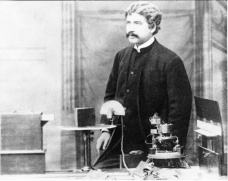Milestones:First Millimeter-wave Communication Experiments by J.C. Bose, 1894-96
First Millimeter-wave Communication Experiments by J.C. Bose, 1894-96
Sir Jagadish Chandra Bose, in 1895, first demonstrated at Presidency College, Calcutta, India, transmission and reception of electromagnetic waves at 60 GHz, over a distance of 23 meters, through two intervening walls by remotely ringing a bell and detonating gunpowder. For his communication system, Bose developed entire millimeter-wave components such as: a spark transmitter, coherer, dielectric lens, polarizer, horn antenna and cylindrical diffraction grating.
In 1895, Jagadish Chandra Bose first demonstrated in Presidency College, Calcutta, India, transmission and reception of electromagnetic waves at 60 GHz, over 23 meters distance, through two intervening walls by remotely ringing a bell and detonating some gunpowder. For his communication system, Bose pioneered in development of entire millimeter-wave components like a spark transmitter, coherer, dielectric lens, polarizer, horn antenna, and cylindrical diffraction grating. This is the first millimeter-wave communication system in the world, developed more than 100 years ago. This is the oldest Milestone achievement from the Asian continent.
For his communication system, Bose pioneered development of a host of millimeter-wave components that included a spark transmitter, coherer, dielectric lens, polarizer, horn antenna, and cylindrical diffraction grating. Bose chose quasi-optical, millimeter-wave frequency range.The wavelengths he used ranged from 2.5 cm to 5 mm. The reason for the choice of millimeter wave by Sir J.C. Bose was primarily due to the advantage of studies of quasi-optical properties of the radio waves within his laboratory of limited size, that was available to him at the Presidency College. However, the components and systems developed by Sir J.C. Bose, initially at millimeter wave and subsequently at microwave, were outstanding discoveries made more than 100 years ago, in Calcutta, India, most of which are now being used, in a modernized form for Earth/space links and remote sensing.
The plaque may be viewed in the main corridor of the A.J.C. Bose Auditorium in the Main Building of Presidency College, Kolkata, India
References and Further Reading
1. D.T. Emerson, The Work of Jagadis Chandra Bose: 100 Years of MM-Wave Research, National Radio Astronomy Observatory (www.tuc.nrao.edu/~demerson/bose/bose.html).
2. Dipak L. Sengupta and Tapan K. Sarkar, "Centennial of the Semiconductor Diode Detector," Proceedings of the IEEE 86, No. 1 (January 1998), p. 235.
3. Jagadis Chunder Bose, "Detector for Electrical Disturbances Patent," [reprint] Proceedings of the IEEE 86, No. 1 (January 1998), p. 229.
4. Jagadis Chunder Bose, "On the Selective Conductivity Exhibited by Certain Polarising Substances" [reprint], Proceedings of the IEEE 86, No. 1 (January 1998), p. 225.
5. Jagadis Chunder Bose, "On a Self-Recovering Coherer and the Study of the Cohering Action of Different Metals" [reprint], Proceedings of the IEEE 86, No. 1 (January 1998), p. 244.
6. Photograph from Acharya Jagadis Chandra Bose, Birth Centenary, 1858-1958. Calcutta: published by the Birth Centenary Committee, printed by P. C. Ray, November 1958.
Letter from the site owner giving permission to place IEEE milestone plaque on the property
Map
